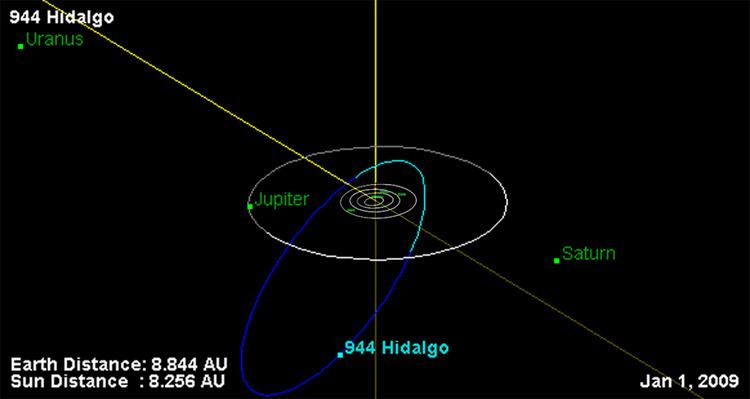Discovered by Walter Baade Alternative names 1920 HZ Aphelion 9.5314 AU (1.42588 Tm) Discovered 31 October 1920 Spectral type C-type asteroid Named after Miguel Hidalgo y Costilla | Discovery date 31 October 1920 Observation arc 32621 days (89.31 yr) Orbital period 14 years Orbits Sun Discoverer Walter Baade | |
 | ||
Minor planet category Jupiter-crosser asteroid,
Saturn-crosser asteroid
centaur Similar Sun, Solar System, 53311 Deucalion, 58534 Logos, 65489 Ceto | ||
944 Hidalgo (/hᵻˈdælɡoʊ/ hi-DAL-goh) is a small Solar System body with a semi-major axis beyond Jupiter's and an orbital period of 13.77 years. This makes it a centaur, the first to be discovered, but it was discovered in 1920 and has hence traditionally been called an asteroid. Hidalgo is estimated to be 38 km in diameter.
Contents
Discovery and subsequent studies
944 Hidalgo was discovered by Walter Baade on October 31, 1920 at Bergedorf Observatory near Hamburg, Germany. It is named for Miguel Hidalgo y Costilla, who was responsible for declaring Mexico's independence in 1810 and the ensuing Mexican War of Independence. German astronomers who were in Mexico to observe a total eclipse on September 10, 1923, had an audience with President Álvaro Obregón. During this meeting, they asked his permission to name the asteroid after Hidalgo.
It was one of five minor planets included in the 1993 study, Transition Comets—UV Search for OH Emissions in Asteroids, which was research involving amateur astronomers who were permitted to make use of the Hubble Space Telescope.
In the late 1990s, a network of astronomers worldwide gathered light curve data that was ultimately used to derive the spin states and shape models of 10 new asteroids, including 944 Hidalgo. The authors describe the shape model as having 'very large flat areas and a "rectangular" pole-on silhouette, which are strong indications of a highly nonconvex shape'. Some of the light curves show sharp minima, which indicates the object shape may have two lobes. Lightcurve data has also been recorded by observers at the Antelope Hills Observatory, which has been designated as an official observatory by the Minor Planet Center.
When Pluto was discovered Hidalgo was the furthest known minor planet from the Sun.
Orbit
944 Hidalgo is a centaur because it has a semi-major axis between Jupiter's and Neptune's. Despite this, the Minor Planet Center (MPC) does not list it as a centaur. Hidalgo has traditionally been considered an asteroid because centaurs were not recognized as a distinct class until the discovery of 2060 Chiron in 1977.
With a high eccentricity of 0.66, its perihelion of 1.95 AU takes it to the inner edge of the asteroid belt, whereas its aphelion of 9.54 AU takes it out to Saturn's orbit, a characteristic normally associated with Saturn's family of comets. Some astronomers therefore suspect that it was once a comet. Strictly speaking, Hidalgo is a Saturn-grazer rather than a Saturn-crosser as its aphelion does not clear Saturn's. Hidalgo's severe orbital inclination of 43° is suspected to be the result of a close encounter with Jupiter. Even as recently as 1922, Hidalgo passed within 0.89 AU of Jupiter. The orbit of Hidalgo has a Jupiter Minimum orbit intersection distance (MOID) of only 0.33 AU (49,000,000 km; 31,000,000 mi).
